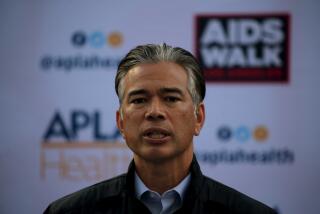Health Insurance Lobby Spends Millions on Debate Spin Control : Legislation: Industry reacts to increasing pressure on Congress for reforms. Unions, doctors, consumers also press their views.
WASHINGTON — Dale Dettra, a demographic analyst at CIGNA Corp., wanted to know more about the national debate over health-care reform.
So, when Dettra, 35, of Chester, Conn., received two invitations--one from his congressman, the other from his company--to a meeting on the subject, he decided to attend, thereby becoming part of a discussion with far-reaching implications for his company and the nation.
Like other insurance companies around the country, CIGNA had written to its 8,000 employees in Connecticut, asking them to help counter what the 50-year-old industry sees as the biggest political threat to its livelihood: a growing public perception that the U.S. health-care system needs to be overhauled and agitation for Congress to respond.
With more than $200 billion in business potentially in jeopardy and public opinion still in the formative stage, the industry has adopted tactics normally used by presidential campaigns.
It is using every possible tool to block the implementation of national health insurance and what is seen as the next worse enemy--a plan known as “play or pay” under which businesses would have to provide insurance to all employees or contribute to a national insurance fund. The proposals would put commercial health insurers virtually out of business, industry executives say.
The insurance industry is just one of many forces attempting to shape the outcome of the health-care debate. Labor unions, medical professions and groups representing the elderly and consumers also are weighing in, although most cannot compete with the political and financial muscle of the insurers.
“The people on the other side are much better funded. Of course, that makes it much harder,” said Sidney M. Wolfe, head of Public Citizen’s Health Research Group, a nonprofit organization founded in 1971 by Ralph Nader. It favors a tax-financed plan of universal health insurance along the Canadian model.
While the issue is highly charged in this election year, the industry expects the battle to continue regardless of who wins the presidency in November.
Through their trade association, the Health Insurance Assn. of America, the major insurance companies have signed up well-regarded public relations consultants and one of the nation’s largest lobbying firms to spread the message that the system needs only a series of incremental changes to ensure near-universal coverage at reasonable cost.
“We have built up our armament,” said Linda Jenckes, the association’s senior vice president. “We want to make sure our proposals pass.”
Jenckes estimated that the association will spend $4 million to $5 million on its campaign during the next two years. The figure does not include spending by member companies; non-members, such as CIGNA; business allies or political action committees.
In addition, the industry is relying on its access to congressional leaders, developed through years of lobbying and campaign contributions. One recent study by Common Cause found that of the more than $60 million that medical industry political action committees gave to congressional candidates from 1981 to mid-1991, $19 million came from insurance groups. That was second only to the $27 million from the American Medical Assn. and other medical profession political action committees.
Insurance companies also can count on thousands of experienced employees strategically scattered across the country. They can use their workers to carry the debate over the heads of members of Congress and directly to millions of Americans concerned about double-digit annual increases in health insurance costs and restrictions that make coverage harder to obtain.
That is what they did Jan. 14, when Democrats tried to tap into the public disenchantment. From Maine to Hawaii, about 200 Democratic House members held meetings the same night to call attention to the crisis and, in some cases, to advocate solutions the industry vigorously opposes.
Dettra said he attended a meeting in Norwich, Conn., sponsored by U.S. Rep. Sam Gejdenson (D-Conn.), because he was interested in the health-care debate.
“For me, it was an educational tool,” said Dettra. “I just wanted to see what the issues were and get a better feel for what is going on in Washington.”
Although he did not speak at the meeting, Dettra said he thought his time was well spent because it reinforced his view--the same one held by CIGNA--that the insurance industry should be given a chance to show that it can reform the nation’s health-care system.
While the meetings nationwide produced wide-ranging, often vigorous discussions, they yielded no consensus among Democrats. Indeed, one still does not appear to exist.
The industry’s campaign began months earlier. Two pollsters, one Democratic and one Republican for credibility, were hired to study Americans’ attitudes about health care. The results, deliberately released the day before the meetings, were mixed. But, from the industry’s point of view, they contained a very important piece of information: The public is much more inclined to try to fix the present system than abandon it.
Although no one is certain whether any converts were made the day of the town meetings, insurance executives said they are happy with the effort. “The response we got back was generally positive,” said Timothy R. Campbell, vice president for government affairs at Travelers Corp. in Hartford.
The year began with health-care reform emerging as one of the hot topics on the presidential campaign agenda. While the issue has subsided somewhat in recent months, the pollsters hired by the industry have predicted that calls for reform will be an important element of the fall campaign and have said the industry must be perceived as on the side of significant change.
In an effort to broaden its appeal, the industry also has formed strategic alliances with two coalitions that share its objectives. One is the Healthcare Leadership Council, a group of 50 chief executives in the health-care field. The other is the much-larger Healthcare Equity Action League, which represents more than 500, mostly small companies.
While the insurance industry is constantly seeking ways to get its message across at the local level, it is relying on a longtime Washington insider to run the leadership council on a day-to-day basis. Pamela Bailey had extensive health-care experience in the Richard M. Nixon and Ronald Reagan administrations before becoming president of the council.
Bailey’s contacts, some said, helped the council arrange a meeting with President Bush and his top advisers about three weeks before the President announced his own reforms, which essentially mirrored the industry’s proposals.
Insurers do not have the lobbying field to themselves, of course. Unions and consumer groups, for example, are trying to move the debate in a very different direction.
Labor and consumer groups do not pretend to have the same access to politicians enjoyed by the insurance industry and its allies, although they do have millions of members who can be mobilized.
The Public Citizen’s Health Research Group and another group active in the debate, Families USA, try to get their messages out largely by issuing research reports that counter the position of the insurance industry and its allies.
More to Read
Inside the business of entertainment
The Wide Shot brings you news, analysis and insights on everything from streaming wars to production — and what it all means for the future.
You may occasionally receive promotional content from the Los Angeles Times.










